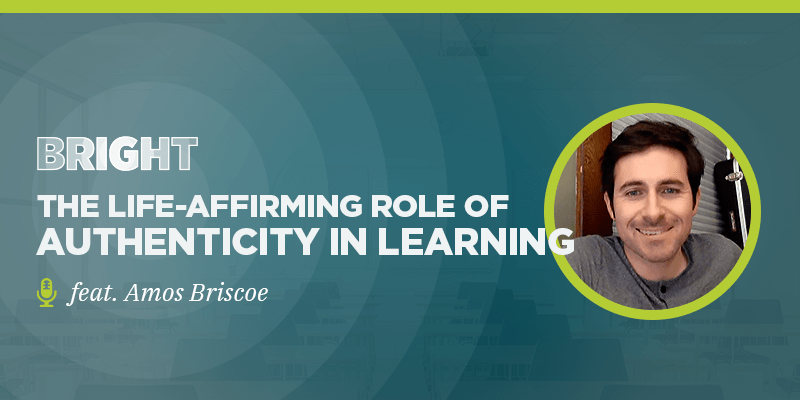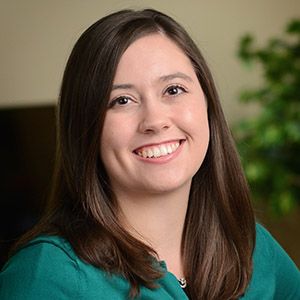Authenticity is a key aspect of Amos Briscoe’s teaching style, but it took him a while to figure that out.
After his first three years of teaching, Briscoe left the profession feeling as though he had failed. During those first few years, he never quite felt like himself when teaching — instead he felt a bit like an imposter or an actor on a stage in front of his students.
Like Joy Taylor, who I spoke with in a previous episode, Briscoe now works for WAVE — the Washtenaw Alliance for Virtual Education. There, he teaches art for students who needed an alternative to the traditional classroom model in order to thrive.
Today, authenticity plays a significant role in Briscoe’s classroom.
“What does the future of learning look like?” he asks. “I know for me, it’s going to be centered on relationships — knowing one another and realizing that education is a social activity. I want to tell jokes while I teach. I want to do life while I teach. And I want to teach because of life. It’s easy to remove learning and teaching from the context that it belongs, and I’m just trying to put it back.”
A journey toward authentic teaching
Briscoe’s path into teaching wasn’t a typical one.
He started off in a traditional classroom setting feeling like there was a disconnect between what he was doing and who he really was.
By the time he finally left the classroom after three years, he felt as though he had failed.
When I asked him what happened during those three years, he told me:
“I’ll be honest, that it’s not something that I’ve investigated as much as I should because it’s painful. When I think back on it, it was really an old fashioned model. There was a sense in which when you’re in front of an audience that you should know what you’re talking about. You should be giving things to an audience that should be thankful for receiving them.”
Practices come from belief, he says, and his beliefs about teaching at the time led him to be someone he wasn’t comfortable being.
“I sort of felt like an actor on a stage,” he admits. “It put me in a bad place. Somehow, I made it three years and never really felt myself. In those three years, I didn’t feel like I was being honest in any way.”
However, after traveling and doing odd jobs around the country, Amos returned to the classroom, this time at WAVE, where they offer “a flexible, student-centered, project-based approach to learning for students who need an alternative to the traditional high school model.”
Here, his beliefs about learning were transformed and he was finally able to become the teacher he’d always wanted to be.
“When the system allowed me to have real, authentic relationships with people, I found a way forward,” he says. “When the system was causing me to be a performer, and to address students that I didn’t know well— what sorts of lives they’d led or problems they’d had — that’s when things were falling apart for me.”
Learning as a social activity
Briscoe’s value of authenticity clearly translates to his view of what is most important in learning.
He defines learning as a fundamentally social activity and articulates his feeling that there is some falseness to siloening learning into separate subject areas.
“I think learning is a social activity like any other,” he says. “The problem that schools have to overcome is that it’s pretty easy to remove that social context. It’s easy to silo things into subject matters and pretend that some things, like social studies, exist over here in this place, but learning how to play the piano is over here and learning how to change a tire is in another place. This is all really the same activity. We learn for social reasons. These reasons are the motivators and the context. My vision for learning is building that social activity back in.”
In his art classroom, social context brings a unique flavor to learning.
“I feel like my fundamental responsibility as an art teacher is to show people that art isn’t some high-up thing that they can’t achieve.”
“I feel like my fundamental responsibility as an art teacher is to show people that art isn’t some high-up thing that they can’t achieve,” he explains. “A lot of people say, ‘I can’t draw, or ‘I can’t learn another language’ or ‘I can’t play music,’ but these things are myths. It’s my job to make art theirs and to see that they are artists because they were born a human being.”
Some of his favorite teaching moments have come from breaking down those siloes and having authentic learning experiences with students.
“The young people I meet are often disillusioned with the way the world is,” he says. “I think they know things that we don’t, and I’m trying to find out what those things are and give them a platform to express those things. There are real things happening on places like Reddit and YouTube that go beyond any sort of lecture I’ve heard in a public school. Kids are teaching other kids, and I want to somehow tap into this in my classroom.”
Building authentic relationships online
Though Briscoe designed his art curriculum to function in both a fully face-to-face and a fully virtual setting, he says that he’s missed seeing his students in person since the COVID-19 pandemic began.
To create space for relationship-building in his currently 100% virtual classroom, he has begun hosting open-ended video conference sessions where students can come ask questions or share their thoughts.
“Any sort of relationship that is happening right now,” he says “is happening through video conferencing that is open-ended and not teacher led.”
This statement echoes a theme I’ve heard often from our online teachers at Michigan Virtual: Having an asynchronous online curriculum can free teachers up to focus on building one-on-one relationships with students.
They often say it shifts the teacher’s role from serving as a “sage on a stage” to instead serving as a “guide on the side.”
At the beginning of his career, feeling pressure to be a “sage on a stage” led Briscoe to feeling somehow like an imposter in his own classroom.
But when he switched to occupying more of a facilitator role, he was able to make learning more authentic for his students and for himself.
See also: Transitioning to remote learning (free online PD for teachers)
A state of “constant experimentation” during COVID-19
Throughout our conversation, Briscoe and I also discussed how learning has looked different during COVID-19 and how he hopes the education system will evolve as a result.
“It feels like it’s been a state of constant experimentation that I’m hoping is going to lead to somewhere.” he says. “We’ve changed everything. We’ve changed our structure. We’ve tried to do so many different things.”
This state of “constant experimentation” has been exhausting, yes, he admits, but it also resulted in many new things that worked well and will continue to be incorporated into their curriculum even after the pandemic is over.
At WAVE, for example, they started hosting “parent nights,” where families share their reflections on what’s working and what isn’t.
“After this is over, I hope people at least don’t stop questioning things,” he says. “That’s one thing we’ve gained. For example, I thought we couldn’t afford having Internet access and computers for every student, but it turns out we can. There are things we’ve learned and like priorities we’ve reset that I hope don’t stop.”
An ode to the life-affirming role of authenticity in learning
All in all, our conversation was an ode to life-affirming role of authenticity in the learning process, particularly:
- Being able to be your authentic self as an educator
- Building authentic relationships with students
- Creating authentic social contexts for learning
At the end of our conversation, I asked Brisoce about his favorite teacher.
His answer?
Mr. Fred Rogers.
In many ways, this answer brought everything full circle.
“During those first three years I was a teacher, what I was doing wrong is precisely what I see Mr. Rogers doing right,” Briscoe reflects. “He’s super present, you know, and he puts his whole attention span towards the person he’s talking to. He’s listening deeply. When he’s having a conversation with a person, he’s able to be led wherever, and he’ll find a teaching moment in that place. That’s what I like about him. Things that we call ‘social emotional learning’ now, I watched him do those things without having a name for it. He was just being a good human being.”
“I guess that’s really my whole philosophy. Let’s try to deal with stuff together and be present with one another.”
“I guess that’s really my whole philosophy,” he summarizes. “Let’s try to deal with stuff together and be present with one another.”

